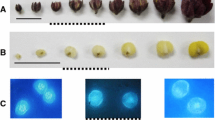Abstract
Triploid plants were grown from the diploid pear scion cultivar (Pyrus pyrifolia Nakai) by anther culture. Androgenic callogenesis occurred at about 10 days after anther excision, and most calli formed within four weeks and stopped growing at less than 1–3 mm in diameter. Androgenic embryogenesis occurred within 8–12 weeks after anther culture. The formed embryos were generally white, globular or heart-shaped. To increase callogenesis and embryogenesis, the effects of cold pre-treatment, light and activated charcoal (AC) on anthers collected from buds were investigated. Cold pre-treatment, dark and lack of AC increased callogenesis more than no cold pre-treatment, light and adding AC. A decisive condition was not found for embryogenesis. The embryogenesis frequency was extremely low and only six embryos were grown. Two embryos expanded greenish cotyledons and developed foliage, and they proliferated when transferred monthly to fresh proliferation medium. The proliferated shoots were rooted and acclimated. Flow cytometric analysis and investigation of the number of chromosomes of regenerants showed that all cells were triploid.
Similar content being viewed by others
References
Bouvier, L., P. Guérif, M. Djulbic, C.E. Durel, E. Chevreau & Y. Lespinasse, 2002. Chromosome doubling of pear haploid plants and homozygosity assessment using isozyme and microsatellite markers. Euphytica 123: 255–262.
Bouvier, L., Y.X. Zhang & Y. Lespinasse, 1993. Two methods of haploidization in pear, Pyrus communis L: Greenhouse seedling selection and in situ parthenogenesis induced by irradiated pollen. Theor Appl Genet 87: 229–232.
Germanà, M.A. & B. Chiancone, 2003. Improvement of Citrus clementina Hort. Ex Tan. Microspore-derived embryoid induc-tion and regeneration. Plant Cell Rep 22: 181–187.
Höfer, M., 1994. In vitro androgenesis in apple: Induction, regeneration and ploidy level. In: H. Schmidt & M. Kellerhals (Eds.), Progress in temperate fruit breeding, pp. 399–402. Kluwer Academic Publishers, Dordrecht.
Höfer, M. & Y. Lespinasse, 1996. Haploidy in apple. In: S.M. Jain, S.K. Sopory & R.E. Veilleux (Eds.), In vitro haploid production in higher plants. Vol 3, pp. 261–276. Kluwer Academic Publishers, The Netherlands.
Iyer, R.D. & S.K. Raina, 1972. The early ontogeny of embry-oids and callus from pollen and subsequent organogenesis in anther cultures of Datura metel and rice. Planta 104: 146–156.
Kadota, M., T. Hirano & K. Imizu, 2001. Double-phase in vitro culture using sorbitol increases shoot proliferation and re-duces hyperhydricity in Japanese pear. Sci Hort 89: 207–215.
Kadota, M., D.S. Han & Y. Niimi, 2002a. Plant regeneration from anther-derived embryos of apple and pear. HortSci 37: 962–965.
Kadota, M., T. Hirano, K. Imizu & Y. Niimi, 2002b. Pyroligneous acid improves in vitro rooting of Japanese pear cultivars. HortSci 37: 194–195.
Kadota, M. & Y. Niimi, 2002. In vitro induction of tetraploid plants from a diploid Japanese pear cultivar (Pyrus pyrifolia N. cv. Hosui). Plant Cell Rep 21: 282–286.
Kadota, M. & Y. Niimi, 2003. Effects of cytokinin types and their concentrations on shoot proliferation and hyperhydricity in in vitro pear cultivar shoots. Plant Cell Tiss Org Cult 72: 261–265.
Kiss, J., M. Kondràk, O. Törjék, E. Kiss, G. Gyulai, K. Màzik-Tökei & L.E. Heszky, 2001. Morphological and RAPD analy-sis of poplar trees of anther culture origin. Euphytica 118: 213–221.
Lespinasse, Y., L. Bouvier, M. Djulbic & E. Chevreau, 1999. Hap-loidy in apple and pear. Acta Hort 484: 49–54.
Lloyd, G. & B. McCown, 1981. Commercially-feasible mi-cropropagation of mountain laurel, Kalmia latifolia,byuse of shoot-tip culture. Proc Inter Plant Prop Soc 30: 421–427.
Murashige, T. & F. Skoog, 1962. A revised medium for rapid growth and bioassays with tobacco tissue culture. Physiol Plant 15: 73–97.
Narayanaswamy, S. & L.P. Chandy, 1971. In vitro induction of hap-loid, diploid and triploid androgenic embryoids and plantlets in Datura metel L. Ann Bot 35: 535–542.
Predieri, S., 2001. Mutation induction and tissue culture in improving fruits. Plant Cell Tiss Org Cult 64: 185–210.
Sanford, J.C., 1983. Ploidy manipulations. In: Moore J.N. & J. Janick (Eds.), Methods in fruit breeding, pp. 100-123. Purdue University Press, West Lafayette Ind.
Sugiura, A., T. Ohkuma, Y.A. Choi & R. Tao, 2000. Production of nonaploid (2n =9x) Japanese persimmons (Diospyros kaki) by pollination with unreduced (2n =6x) pollen embryo rescue culture. J Amer Soc Hort Sci 125: 609–614.
Sunderland, N., G.B. Collins & J.M. Dunwell, 1974. The role of nuclear fusion in pollen embryogenesis of Datura innoxia Mill. Planta 117: 227–241.
Thomas, T.D., A.K. Bhatnagar & S.S. Bhojwani, 2000. Production of triploid plants of mulberry (Morus alba L) by endosperm culture. Plant Cell Rep 19: 395–399.
Verdoodt, L., A. Van Haute, I.J. Goderis, K. De Witte, J. Keulemans & W. Broothaerts, 1998. Use of the multi-allelic self-incompatibility gene in apple to assess homozygocity in shoots obtained through haploid induction. Theor Appl Genet 96: 294–300.
Zhang, Y.X. & Y. Lespinasse, 1991. Pollination with gamma-irradiated pollen and development of fruits, seeds and partheno-genetic plants in apple. Euphytica 54: 101–109.
Zhang, Y.X. & Y. Lespinasse, 1992. Haploidy. In: F.A. Hammerschlag & R.E. Litz (Eds.), Biotechnology of Parennial Fruit Crops, pp. 57-75. CAB International, Wallingford.
Zhang, Y.X., Y. Lespinasse & E. Chevreau, 1990. Induction of haploidy in fruit trees. Acta Hort 280: 293–305.
Author information
Authors and Affiliations
Rights and permissions
About this article
Cite this article
Kadota, M., Niimi, Y. Production of triploid plants of Japanese pear (Pyrus pyrifolia Nakai) by anther culture. Euphytica 138, 141–147 (2004). https://doi.org/10.1023/B:EUPH.0000046756.01934.34
Issue Date:
DOI: https://doi.org/10.1023/B:EUPH.0000046756.01934.34




